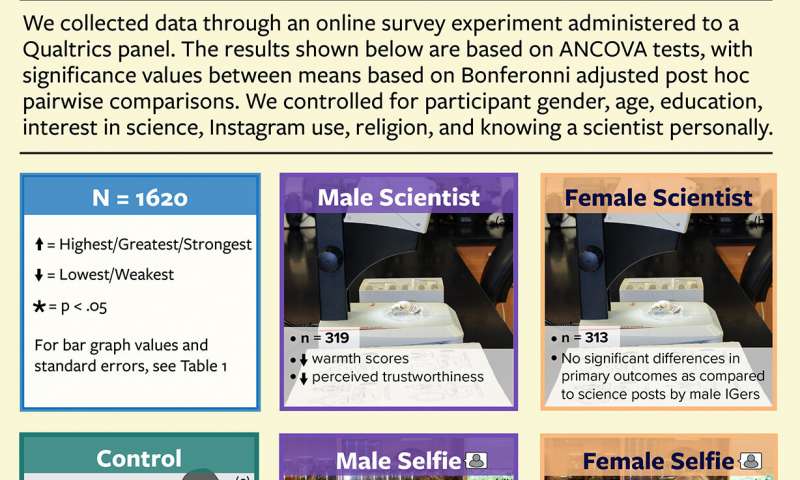The study builds on seminal work by Princeton University social psychologist Susan Fiske suggesting that scientists have earned Americans’ respect but not their trust. Trust depends on two perceived characteristics of an individual or social group: competence and warmth. Perceptions of competence involve the belief that members of a particular social group are intelligent and have the skills to achieve their goals. Perceptions of warmth involve the belief that the members of this group also have benevolent goals, or that they are friendly, altruistic, honest and share common values with people outside of their group. Together, perceptions of competence and warmth determine all group stereotypes, including stereotypes of scientists.
“Scientists are famously competent—people report we’re smart, curious, lab nerds—but they’re silent about scientists’ more human qualities,” Fiske said.
While perceptions of both the competence and the warmth of members of a social group are important in determining trust and even action, it turns out that perceived warmth is more important. And, as Fiske showed in a study published in 2014 in Proceedings of the National Academy of Sciences, Americans see scientists as competent but only as moderately warm. Scientists’ perceived warmth is on par with that of retail workers, bus drivers and construction workers but far below that of doctors, nurses and teachers.
The researchers of the new PLOS ONE study launched the investigation into perceptions of scientist Instagrammers after being struck with the idea that the competence versus warmth stereotype of scientists may not be an insurmountable challenge given the power of social media to bring scientists and nonscientists together.
[…]
To explore this idea, the team launched a research project popularly referred to as ScientistsWhoSelfie, based on the hashtag the researchers introduced to raise awareness about the project in an online crowdfunding campaign that raised more than $10,000. A few dozen scientists around the globe helped to develop a series of images for the project.
The idea was to show research participants images published to one of four different “Scientists of Instagram” rotation-curation accounts and then to ask them questions about their perceptions of the scientists represented in these images as well as of scientists in general. Each participant was shown three types of images: a scientific setting or a piece of equipment such as a microscope, a bioreactor on the lab bench or a plant experiment set-up in a greenhouse with no humans in any of the images but with captions attributing the images to either male or female scientists by name; a smiling male scientist looking at the camera in the same scientific setting; or a smiling female scientist looking at the camera in the same scientific setting.
A total of 1,620 U.S.-representative participants recruited online viewed these images in an online survey. People who saw images including a scientist’s smiling face, or “scientist selfies,” evaluated the scientists in the images and scientists in general as significantly warmer than people who saw control images or images of scientific environments or equipment that did not include a person. This perception of scientists as warm was especially prominent among people who saw images featuring a female scientist’s face, as female scientists in selfies were evaluated as significantly warmer than male scientists in selfies or science-only images. There was also a slight increase in the perceived competence of female scientists in selfies. Competence cues such as lab coats and equipment likely played a role in preserving the perceived competence of scientists in selfies.
“Seeing scientist selfies, but not images of scientific objects posted by scientists online, boosted perceptions that scientists are both competent and warm,” said lead author LSU alumna Paige Jarreau, who is a former LSU science communication specialist and current director of social media and science communication at LifeOmic. “We think this is because people who viewed science images with a scientist’s face in the picture began to see these scientist communicators on Instagram not as belonging to some unfamiliar group of stereotypically socially inept geniuses, but as individuals and even as ‘everyday’ people with ‘normal’ interests—people who, like us, enjoy taking selfies! Female scientists, in particular, when represented in substantial numbers and diversity, may cause viewers to re-evaluate stereotypical perceptions of who a scientist is.”
The team further found that seeing a series of female scientist selfies on Instagram significantly shifted gender-related science stereotypes, namely those that associate STEM fields with being male. However, they also found that people who saw female scientist selfies evaluated these scientists as significantly more attractive than male scientist selfies. This might help explain female scientists’ boosted warmth evaluations, as physical attractiveness is positively associated with perceived warmth. However, this could also be an indicator that viewers focused more on the physical appearance of female scientists than on male scientists. By extension, female scientists could be more unfairly evaluated for defying gender norms in their selfies, such as not smiling or appearing warm. In their PLOS ONE paper, the team writes that this possibility should be investigated further in future research.
Source: New study shows scientists who selfie garner more public trust

Robin Edgar
Organisational Structures | Technology and Science | Military, IT and Lifestyle consultancy | Social, Broadcast & Cross Media | Flying aircraft

